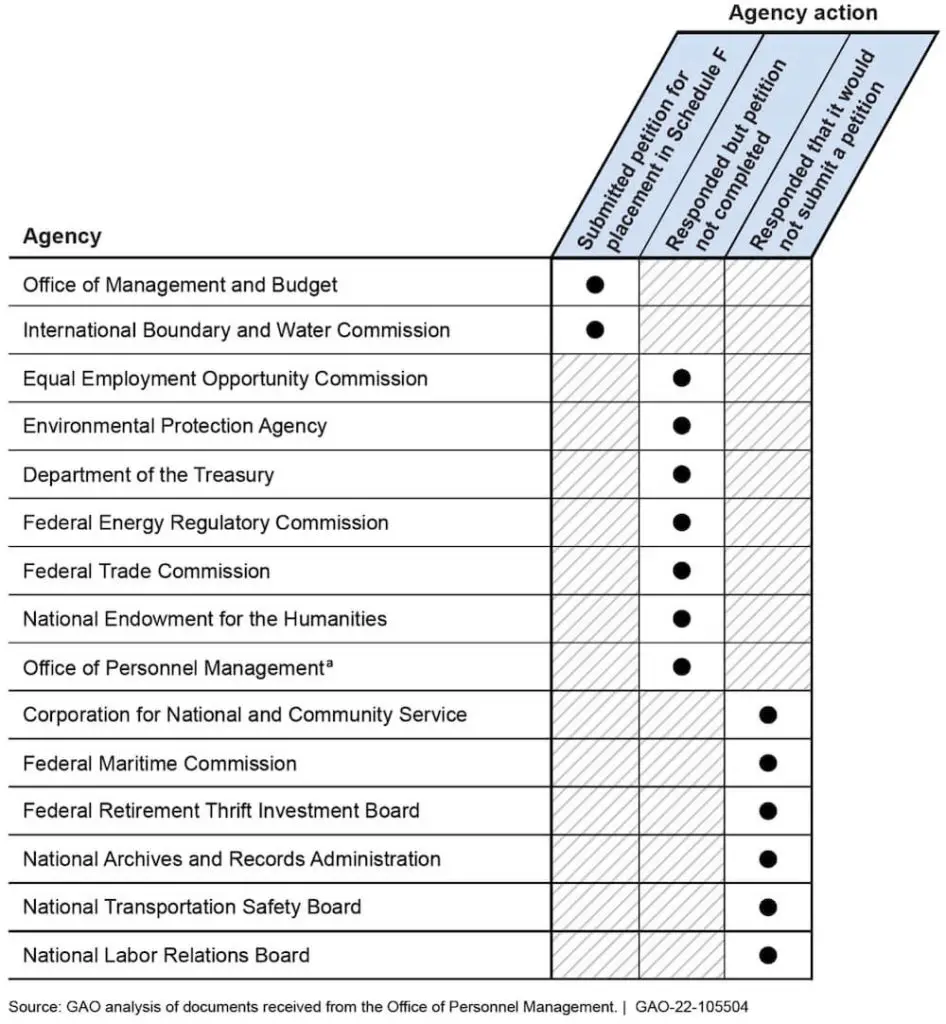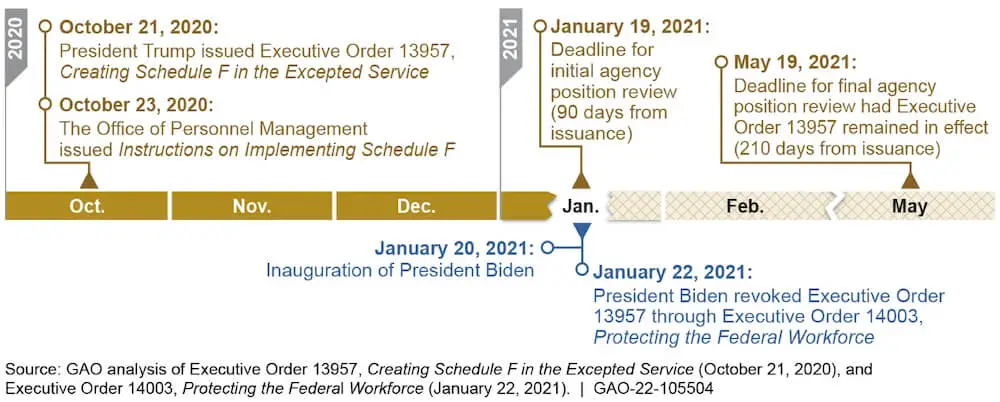The Government Accountability Office has issued a new report detailing the Schedule F implementation plans of federal agencies during its short lifespan in the last days of the Trump administration.
In October of 2020, President Trump issued an Executive Order creating Schedule F, a new class of federal employees that would not be subject to the civil service procedures now applicable to most federal employees for hiring and firing. These federal employees would not have access to the usual array of appeal rights because “Agencies need the flexibility to expeditiously remove poorly performing employees from these positions without facing extensive delays or litigation,” according to the Executive Order. In other words, it would have made it easier to fire federal employees for performance reasons.
Just one month later, at least two federal agencies began working to implement the Executive Order. But were any federal employees actually moved into Schedule F during its existence?
Agency Responses to Schedule F
According to the GAO report, no federal agencies placed any positions into Schedule F before it was revoked by President Biden in January 2021. However, there were at least hundreds of federal employees that would have been affected had the Order remained in place.
GAO wrote:
GAO found no agencies had placed positions into Schedule F by the time of the E.O.’s revocation on January 22, 2021. Two agencies submitted written requests to the Office of Personnel Management (OPM) to place positions into Schedule F. OPM approved the Office of Management and Budget’s (OMB) request to place 136 positions into Schedule F. According to GAO analysis, this affected 415 employees, or 68 percent of OMB’s workforce at the time. OMB officials said agency leadership halted the implementation of Schedule F on January 20, 2021. The U.S. International Boundary and Water Commission requested approval to place five positions (out of its total workforce of 234 at the time) into Schedule F. However, the E.O. was revoked before OPM completed its review.
Additionally, GAO said that 13 other federal agencies communicated with the Office of Personnel Management (OPM) regarding Schedule F before it was revoked. Seven agencies said they needed more time to finalize their analysis of job positions and six said that they would not be placing any job positions into Schedule F.
Of those seven agencies requesting more time, five gave varying reasons as to why they did not ultimately submit a petition to OPM leadership:
- EPA officials stated that they did not have time to do the extensive work required to finalize their petition and did not know if Schedule F would be applicable under the new administration. They also said they were afraid of upsetting their employees. As GAO put it, “They also said their employees would be upset if they learned that EPA was submitting a petition.”
- EEOC and FTC officials told GAO that they were in the preliminary stages of their review at the time the Executive Order was revoked. They said they needed additional time to complete their analysis.
- FERC officials said they submitted a first draft of their petition for OPM’s review and comment. They said that OPM officials had made it clear in Small Agency Council meetings they attended that agencies would receive feedback on the results of their preliminary analysis. FERC officials said they were waiting for OPM’s reaction to their draft before finalizing the petition. The Executive Order was ultimately revoked before FERC officials received a response from OPM.
- OPM officials said that they sent the results of their own preliminary review of positions to agency leadership for approval but that the positions were not approved for placement into Schedule F before the Executive Order was revoked.

The Future of Schedule F
So why is this important? After all, the Executive Order was revoked when President Biden took office.
It is not inconceivable that future presidents would not reinstate Schedule F. GAO wrote:
Future administrations could seek to re-establish Schedule F, or a category of federal positions with similar attributes, according to several stakeholders GAO interviewed. Some stakeholders said this is, in part, because Schedule F could be used to expedite hiring of federal employees committed to advancing the President’s policy agenda, and removing those who were not. Several stakeholders stated that agencies would need to consider important tradeoffs when using Schedule F. These included possible effects to recruiting, retaining experienced staff, and risks such as employees in Schedule F positions being subject to removal for partisan political reasons.
In fact, legislation has been introduced in Congress to prevent this from happening. The Preventing a Patronage System Act (H.R. 302) was sponsored by Congressman Gerry Connolly (D-VA) and recently passed the House.
The legislation prohibits any position in the competitive service from being reclassified to an excepted service schedule created after September 30, 2020. It also would also limit federal employee reclassifications to the five excepted service schedules in use prior to fiscal year 2021 and would block any reclassifications of federal employees to Schedule F pursuant to President Trump’s Executive Order signed on October 21, 2020. Any position in the federal competitive service could not be reclassified outside of merit system principles without consent from Congress.
The bill was drafted out of a worry that Schedule F could resurface amid speculation that former President Trump might run for president again and reinstitute Schedule F if elected. In general, Democrats have been vehemently opposed to Schedule F while Republicans have shown more favor to it.
FedSmith author Ralph Smith summed the debate up concisely in his article about the recent resurgence of worries over Schedule F:
Schedule F discussions, despite concerning and requiring some insight into how the federal bureaucracy actually works, are important and ignite strong reactions. One side is concerned about the lack of control over government policy, how these policies are decided, and the influence of unelected and often invisible decision-makers from inside the federal government.
On the other side of the discussion, there is concern about having more political appointees assuming power after a change in administrations, the lack of continuity in government, the lack of protection for federal employees in the jobs that they have, and the possible rise of a “spoils system” of government.
Both sides have reasonable concerns. Both sides represent vested interests in how government runs and the influences that determine government policies. The intensity of the argument reflects the underlying importance of the issue.
Have we heard the last of Schedule F? That ultimately remains to be seen.



